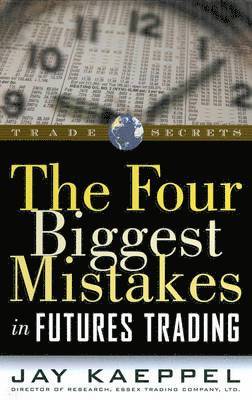
- Format
- Häftad (Paperback / softback)
- Språk
- Engelska
- Antal sidor
- 112
- Utgivningsdatum
- 2000-03-01
- Förlag
- Marketplace Books
- Illustrationer
- black & white illustrations
- Dimensioner
- 222 x 146 x 12 mm
- Vikt
- Antal komponenter
- 1
- ISBN
- 9781883272081
- 181 g
The Four Biggest Mistakes in Futures Trading
Slutsåld
Kundrecensioner
Fler böcker av Jay Kaeppel
-
Seasonal Stock Market Trends
Jay Kaeppel, Kaeppel
There is a seasonal bias to the stock market, and by paying attention to the seasonal market tendencies you can gain an edge in the stock market over the long haul. Seasonality offers a practical approach to investing and trading. What better way ...
-
Four Biggest Mistakes in Option Trading
Jay Kaeppel
With over 50,000 copies in print for the first edition, Kaeppel's insight has undoubtedly made its mark in the options world. Now, he strikes again with an updated and more comprehensive look at those pesky mistakes that traders continue to make i...
Innehållsförteckning
Introduction 1; The Bad News, The Worse News, The Good; News and The Better News 1; Why So Many Fail 1; What Sets Futures Trading Apart 2; Attacking From The Bottom Up Versus The Top Down 3; One Word of Warning 4; Topics To Be Covered 5; Mistake 1: Lack Of A Trading Plan 7; What is Mistake 1 7; Why Do Traders Make Mistake 1 8; The Recipe For Trading Success (That Nobody Wants To Hear) to How To Avoid Mistake 1 11; The Litmus Test 12 How Much Capital Will You Commit To Futures Trading 13; What Market or Markets Will You Trade 14; What Type of Trading Time Frame Is Best For You 16; What Type of Trading Method Will You Use 20; What Criteria Will You Use To Enter a Trade 21; What Criteria Will You Use To Exit A Trade With A Profit 22; What Criteria Will You Use To Exit A Trade With A Loss 23; A Word Of advice: Adhere to the Four Cornerstones 25; Go With The Trend 25; Cut Your Losses 26; Let Your Profits Run/Don't Let Big Winners Get Away 26; Summary 27; Mistake 2: Using Too Much Leverage 29; What is Mistake 2 29; Understanding Leverage 31; Why Do Traders Make Mistake 2 34; How To Avoid Mistake 2 35; The Role of Mechanical Trading Systems 37; Determining The Amount of Capital Required 37; Single Market Factor 1: Optimal f 37; Calculating Optimal f 39; Single Market Factor 2: Largest Overnight Gap 40; Single Market Factor 3: Maximum Drawdown 43; One Caveat to Analyzing Trading System Results 45; Arriving at a Suggested Dollar Value Per Contract 46; Arriving at an Aggressive Suggested Account Size 48; Arriving at a Conservative Suggested Account Size 49; Arriving at an Optimum Suggested Account Size for Your Portfolio 50; Digging a Little Deeper 51; Summary 52; Mistake 3: Failure To Control Risk 55; What is Mistake 3 55; Why Do Traders Make Mistake 3 56; How To Avoid Mistake 3 58; Risk Control Method 1: Diversification Among Different Markets 60; Risk Control Method 2: Diversification Among Trading Time Frames and Methods 63; Risk Control Method 3: Proper Account Sizing 65; Risk Control Method 4: Margin-to-Equity Ratio 66; Risk Control Method 5: Stop-Loss Orders 69; Placing a Stop-Loss Order In the Market Place 69; Using Mental Stops 71; Not Using Stop-Loss Orders At All 73; The One Important Benefit of Stop-Loss Orders 74; Summary 75; Mistake 4: Lack Of Discipline 77; What is Mistake 4 77; Why Do Traders Make Mistake 4 81; How To Avoid Mistake 4 82; Overcoming The IQ Obstacle 83; A Word of Advice: Don't Think, React 85; Avoid Simple Traps 87; The Cure for Woulda, Shoulda, Coulda 89; System Development versus System Tinkering 91; Asking The Right Question 93; Summary 96; Conclusion 98; Appendix A: Mathematical Formula for Standard Deviation 103; Standard Deviations 103
Du kanske gillar
-
Peak Human
Johan Norberg
Häftad -
Peak Human
Johan Norberg
Inbunden -
Atomic Habits
James Clear
Trade paperback (UK) -
Leaders Eat Last
Simon Sinek
Häftad -
7 Habits Of Highly Effective People: Revised and Updated
Stephen R Covey, Sean Covey
Paperback - Trade paperback (UK)
